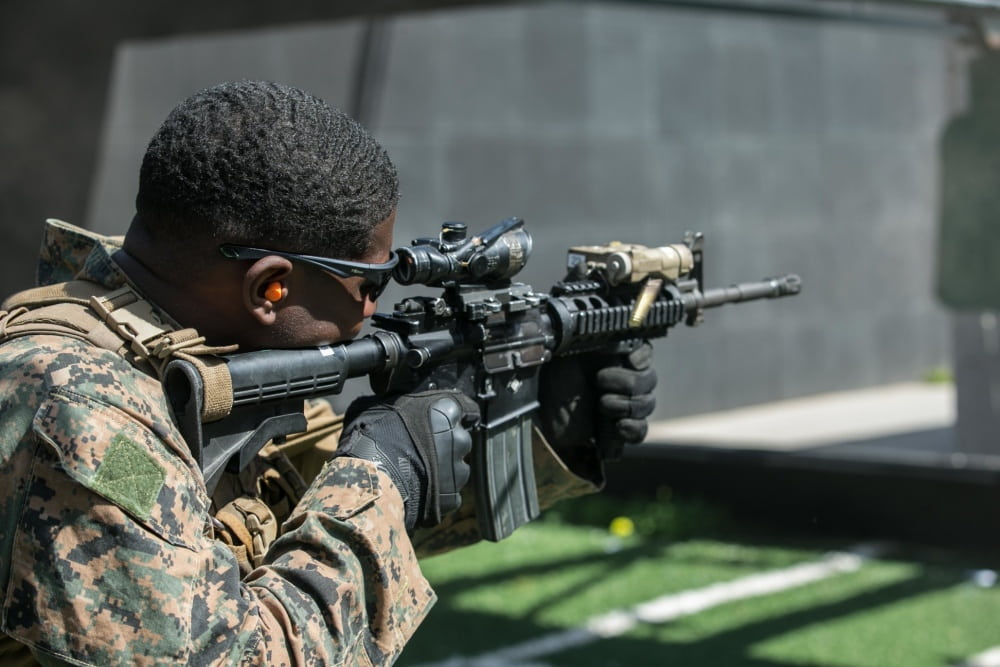The M4 Carbine, designed by Colt Manufacturing Company, is a legendary U.S. military weapon chambered for the 5.56x45mm NATO cartridge. Designed in 1982, this rifle is still in service in more than 60 countries due to its adaptability, ergonomics, and modularity. It is a gas-operated, closed rotating bolt-action rifle that fires approximately 800 rounds per minute with an effective range of 500 meters.
Although the M4 Carbine is an iconic rifle, many civilians confuse it with the M16. This is plausible since the M4 shares many similarities with the M16 but incorporates significant differences. The M4 started as a specialized modification of a full-length rifle and eventually replaced that rifle as the primary general-issue weapon. The M4 has been embraced by over 60 nations worldwide and is produced by various companies, including Colt, Remington, and FN Herstal.
Table of Contents
ToggleTechnical Performance Characteristics
The M4, like its parent rifle (the AR-15/M16), is a lightweight, gas-operated, magazine-fed, air-cooled, select-fire carbine. It shares most features of an AR-pattern firearm, including an internal piston system, a rotating bolt, a reciprocating bolt carrier, and a two-piece aluminum receiver. Notably, the M4 boasts an 80% parts commonality with the M16A2 rifle.
The major differences include the M4’s shorter 14.5-inch barrel compared to the M16’s standard 20-inch barrel, its corresponding shorter gas system and handguard, and its more compact receiver extension and buffer. Early M4s featured the integrated carry handle of the M16, but later versions included a flat-top receiver with a Picatinny rail for easy optic attachment.
The M4A1 variant replaced the original M4’s three-round burst fire mode with full-auto capabilities. Some later M4 models included a SOCOM (Special Operations Command) profile barrel, designed for durability during sustained full-auto fire.
Performance Impact of Barrel Length
Short-barrel rifles like the M4 offer a balance of maneuverability and accuracy, especially at combat distances. The compact design is ideal for urban combat, vehicle crews, and close-quarters engagements.
Vietnam War and the Rise of the M4 Carbine
The need for a compact, maneuverable weapon became apparent during the Vietnam War when troops sought a shortened version of the M16. Colt responded with the CAR-15, which served special operations units but faced limitations due to its short 10-inch barrel. These challenges highlighted the need for further development, eventually leading to the creation of the M4.
The M16 to M4 Transition
The M16, despite its success, remained a full-length rifle unsuitable for confined spaces and urban warfare. In 1982, the military formally requested a carbine version. By 1984, the M4 was approved for development, featuring a 14.5-inch barrel and other refinements. Its compact design and improved functionality made it the preferred weapon for many combat roles.
Testing the Limits: Real-World Operations
The M4’s effectiveness became evident during operations such as the Gulf War, the Battle of Mogadishu, and the Kosovo War. Over two decades of the Global War on Terror saw the M4 replace the M16 as the primary weapon for many U.S. Army and Marine Corps units.
The M4’s compact size, coupled with its ability to fire an effective round against body armor, made it suitable for non-infantry personnel and special operations forces. Today, the U.S. military continues to rely on the M4 Carbine while exploring replacements for future needs.

Muhammad Ismail Mir
The author is a UK-based small arms expert and geopolitical analyst.
- Muhammad Ismail Mir
- Muhammad Ismail Mir
- Muhammad Ismail Mir













